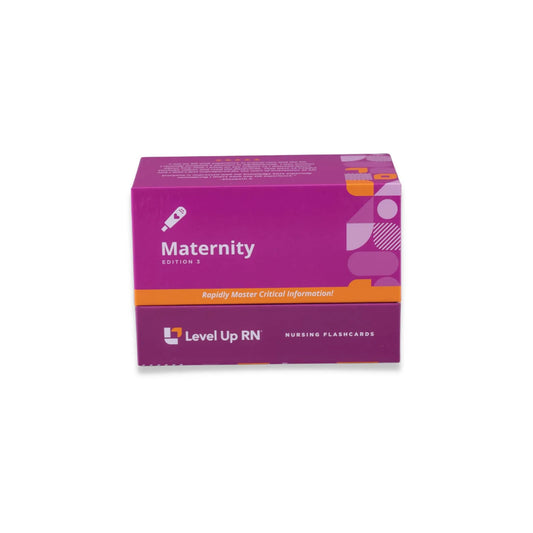Maternity Nursing - Flashcards
This article continues our discussion of the various complications of pregnancy, focusing on hyperemesis gravidarum, iron-deficiency anemia, candidiasis, and urinary tract infections.
This series follows along with our Maternity Nursing Flashcards, which are intended to help RN and PN nursing students study for nursing school exams, including the ATI, HESI, and NCLEX.
Hyperemesis gravidarum
Patients with hyperemesis gravidarum suffer from severe nausea and vomiting that extends beyond the first trimester of pregnancy.
“Hyper” means more than usual, and “emesis” means nausea and vomiting, so hyperemesis means throwing up more than usual — more than the common morning sickness. It is a serious condition of pregnancy, which, if left untreated, could result in the patient vomiting to the point that they become malnourished.
Signs and symptoms of hyperemesis gravidarum
Signs and symptoms of hyperemesis gravidarum, in addition to nausea and vomiting, include dehydration, electrolyte imbalances, and weight loss. These could lead to major complications of the heart and brain, for example.
Pregnancy is a time for gaining weight, so losing weight during pregnancy is a sign something is not right.
Another sign of hyperemesis is the presence of ketones in the urine, a condition called ketonuria. Ketones appear in the urine because of dehydration, and, more specifically, because the patient is not getting the nutrition that they need. This means the body has to break down fat for energy, and in the process of breaking down its fat (its stored energy), keto acids are released. For a pregnant patient, this is potentially deadly if the body has to resort to burning its full backup stores of energy for nourishment.
Treatment of hyperemesis gravidarum
Treatment for hyperemesis gravidarum includes prescribing antiemetics (e.g., ondansetron, metoclopramide, promethazine). Note that most antiemetics are not considered category A (safe to use) for pregnancy.
One antiemetic that is category A is pyridoxine (a combination of vitamin B6 and sleeping medicine), though its efficacy may be limited for a patient suffering from hyperemesis.
If the patient has refractory hyperemesis (the condition is not readily responding to treatment), the provider may prescribe corticosteroids.
A patient with hyperemesis may be so severely ill that they need to have a Zofran pump. A Zofran pump provides a continuous level of Zofran to help control nausea and vomiting. However, some patients are allergic to Zofran, eliminating it as a treatment option.
Nursing care for hyperemesis gravidarum
In terms of nursing care for hyperemesis gravidarum, administer IV fluids and electrolytes as ordered. Monitor their Is and Os and their weight.
Encourage the patient to eat small, frequent meals, and dry or bland foods.
Remember, hyperemesis is going to be a dramatic experience for most patients. They’ll report, “I’m vomiting dozens of times per day. I can keep no food or fluid down, and I feel very sick.” This is an unpleasant, even frightening condition, especially for a pregnant patient.
Candidiasis
Candidiasis is a fungal infection caused by Candida albicans (better known as a “yeast infection”). It is common during pregnancy due to changes in vaginal pH and the flora of the vulva, and because the patient’s immune system is not working as it normally does.
Signs and symptoms of candidiasis
The most obvious and common sign/symptom for candidiasis is a thick white discharge, sometimes described as being like cottage cheese in consistency, and an intense itching, known as pruritus. The patient may also experience burning with urination as well as vaginal inflammation.
Treatment of candidiasis
Candidiasis may be treated with topical antifungal agents, (e.g., clotrimazole, miconazole).
Patient teaching for candidiasis
Patient teaching for someone with candidiasis involves lifestyle modifications.
Patients should avoid wearing tight clothing, which holds moisture close to the body. They should also avoid damp clothing or bathing suits for the same reason.
Patients should not use douching products. Teach them that the vagina is self-cleaning, so there's never a need to douche, which is especially true during pregnancy. Similarly, it is important to avoid using scented feminine products (e.g., scented lotions), which can be irritating to the sensitive skin around the vulva.
Most important, the patient should wear cotton underwear, which is more breathable, allowing for a greater exchange of oxygen while trapping less moisture.
This is also important because one of the physiologic changes of pregnancy is leukorrhea, an increased vaginal discharge, which acts as a protective mechanism. But it also means increased moisture around the vulva (and, therefore, a higher risk for yeast infections). The natural cotton fibers may help to alleviate this.
Iron-deficiency anemia
Iron-deficiency anemia is anemia due to inadequate iron stores and/or insufficient intake of iron-rich foods. When a patient is pregnant, they have a higher blood volume. In order to allow their red blood cells to carry the oxygen they require, they need to have enough iron to allow the hemoglobin to carry that increased oxygen load. That means the patient should be increasing their iron intake, and their caregivers need to be aware if they are iron deficient, which can cause anemia.
Signs and symptoms of iron-deficiency anemia
The signs and symptoms of iron-deficiency anemia include fatigue, shortness of breath, pallor (paleness), and pica (the craving to consume non-food substances, such as clay, dirt, ice, even laundry detergent). Pica is the body’s way of saying it is not getting the nutrients it needs.
Labs for iron-deficiency anemia
Labs will show a decrease in H&H — that is, low levels of hemoglobin and hematocrit (a measurement of the proportion of red blood cells in the blood).
Further labs will indicate low levels of iron and ferritin (a protein that stores and releases iron).
Treatment of iron-deficiency anemia
Treatment for iron-deficiency anemia is simply increasing the patient’s intake of iron. This includes taking ferrous sulfate, which should be taken with vitamin C (to increase absorption).
Nursing care for iron-deficiency anemia
In addition to taking ferrous sulfate, patients should be advised to increase their intake of iron-rich foods (e.g., meat, fish, chicken, liver, green leafy vegetables).
It is also important for the patient to increase their fluid and fiber intake when taking iron supplements (to prevent constipation).
Urinary tract infection (UTI)
A urinary tract infection (UTI) is a bacterial infection in any part of the urinary tract. A UTI should be treated seriously, as it may lead to uterine irritation and preterm labor.
UTI risk factors
Pregnancy (due to urinary tract changes) is a risk factor for a UTI, as are urinary catheterization, frequent pelvic exams, undergoing a C-section, or having a hypotonic bladder.
Signs and symptoms of UTI
It is possible that a patient with a UTI is asymptomatic. For this reason, at the initial first trimester visit, many providers will send off a urine culture to screen for a pre-existing UTI.
For a patient with symptoms of a urinary tract infection, those may include dysuria (painful urination that might be described as burning), and/or frequent and urgent urination (often with only a couple of drops coming out).
Other symptoms include cloudy and/or malodorous urine, fever, chills, fatigue, and suprapubic (above the pubic bone) pain.
Labs and diagnostics for UTI
Labs include urinalysis — a good way to see if there are white blood cells or the products of bacteria in the patient's urine.
Urine may also be sent to the lab for a culture, allowing the provider to know exactly what bacteria may be growing and what antibiotics it is susceptible to. Additional labs include RBC, nitrites, and leukocyte esterase (a screening test used to detect white blood cells in the urine).
Treatment of UTI
Antibiotics are administered to treat a UTI.


